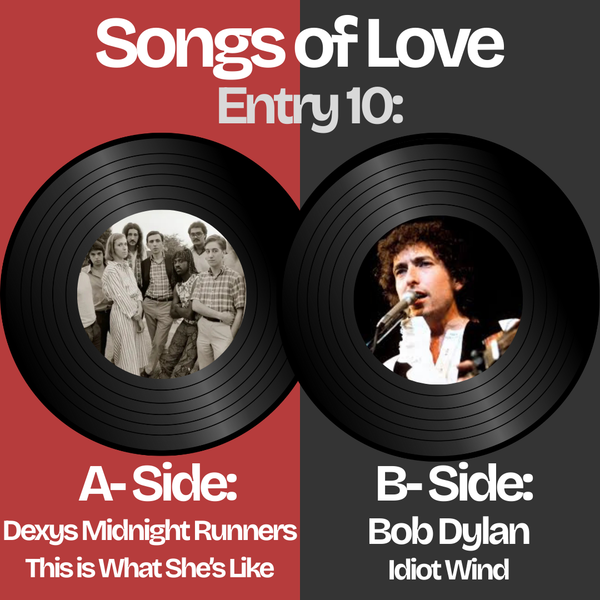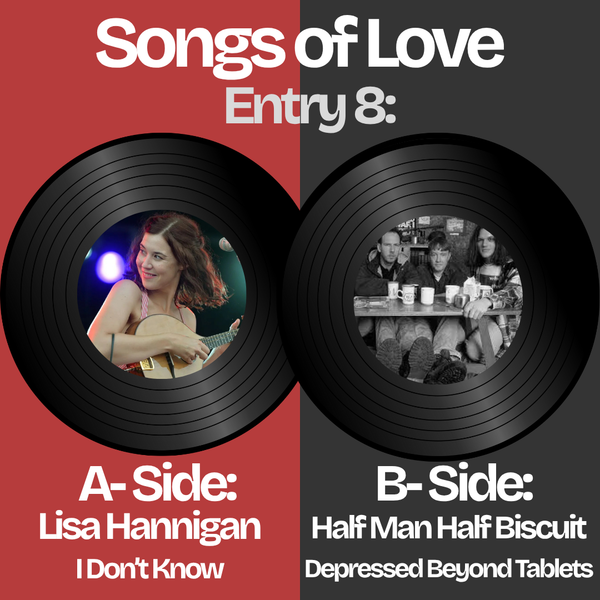Songs of Love 4
This time, two songs from only a couple of years apart, from two of the great male voices of the 20th century. Two singers heavily associated with each other, but also very much associated with ideas of cool. As we’ll see, though, these are both songs that very much undermine that latter idea. These are not cool songs; they’re both, in different ways, achingly sincere and vulnerable. As most great love songs are, in fact.
Performed by Dean Martin
Written by Lionel Newman and Haven Gillespie
Released 1953
It’s those sweeping strings in the intro that draw you in, of course. A perfect picture of old Hollywood glamour – and not the last one we’ll be seeing here – conjuring up images of a dancefloor, of two people gazing into each other’s eyes, of the strings swelling towards the end as they lean towards each other. It feels like it came straight from the soundtrack of a film – as indeed it did, more on that in a bit – and it’s even sung, in this version, by Dean Martin, one of cinema’s great charmers.
And yet that last point is slightly off. Because this song is not about charming, or seducing. It’s about being charmed – “thrill me with your charms.” The singer isn’t the one leaning in for the kiss, they’re the one being leant towards. The entire song, from the title on down, is couched in imperatives – “kiss,” “say,” “hold,” “thrill.” It’s a series of requests, or desires, in which the singer himself is entirely passive.
Yes, himself. Normally I keep these entries as gender-neutral as possible, but the gendered dynamic here is a big part of what I find interesting about it. Because this is, to put it mildly, not what we’d expect from a male singer. It’s not the stereotypically masculine role in the relationship dynamic. This singer is not taking charge, but wishing to be taken charge of. It’s oddly gentle. There’s no real force to the requests – yes, the singer wants to be kissed, to be thrilled and so forth, but they never state when. It doesn’t have to be right this moment, just so long as it happens. Where so many love songs, as we’ve seen, are of the moment, this one has all the time in the world.
And this gendered dynamic becomes all the more interesting when we consider the song’s origins. It was written for the 1953 film Niagara, in which it plays a significant role: Marilyn Monroe’s character is obsessed with it as a song of romantic possibility, symbolising her romance with her extra-marital lover, and sings along with it at one point. What’s more, the film was one of Monroe’s breakouts, and helped to establish her as the symbol of seduction and sexuality that she remains[1]. This makes the contrast all the more striking; a song associated with a female character longing to escape from her turbulent marriage is here abstracted and given to a male singer. And not just any male singer, but one of the great crooners of his generation, one specifically associated with ideas of cool remove on both stage and screen[2]. It’s a curious and powerful undermining by Martin of his usual persona, at a relatively early point in his career.
And like any good song, any good piece of art, it speaks to something wider. There’s a sense of surrender that can come with love, of powerlessness, of giving oneself over to another person. In fact, that’s a big part of what love is: entrusting a large part of yourself, of your life, of your wellbeing to another person. It can sound scary when put like that, and certainly many people find it that way, but it’s also, well, thrilling, and can be intoxicating in and of itself. That’s what this song is about. It’s about placing your heart in another person’s hands, and letting them do what they want with it. There’s a definite sense of lust in this song, but it’s delivered with a gentle smile.
[1] I mean no disrespect to Monroe, a talented and often underrated Method-trained actor and performer who was extremely dedicated to her art; rather, this is how she has become archetypally known in wider culture and, reductive or not, archetypes hold power.
[2] Like Monroe, Martin actually had significant range as a performer – see his performance as a town drunk in Rio Bravo, for instance, which would later inform his stage performances – but again, we’re thinking in archetypes here.
Performed by Frank Sinatra
Written by Richard Rodgers and Lorenz Hart
Released 1955
This is one of the songs that made me want to start this project, a song that captures a very specific feeling more accurately than perhaps any other piece of art I’ve ever encountered, and a performance of that song that strikes right to the heart of it. A song that, depending on my mood, I’ll either listen obsessively to, or skip past quickly for fear of what it might stir up.
There’s a strange, paradoxical and underexplored truth about heartbreak: it’s addictive. It actually feels good, in a strange, masochistic sort of way. Whether it’s a break-up, or (as in this song) unrequited love, it really is “a pleasure to be sad.” Because what heartbreak shares with the happiest of love affairs is that it’s a placing of another person at the centre of your own life. In fact, very often it does that even more than a fully requited affair, in which you have to contend with the messy reality of another independent person. With heartbreak, you get to construct your own, imagined version of them. They can be at the core of your world even more than an actual flesh-and-blood lover, especially as heartbreak is very often by its nature a solitary affair[1], one that prompts a lot of melancholy reflection, isolated (perhaps purposefully) from other people.
And it’s obvious enough that that’s what’s happening in this song, but it’s not all that’s going on. Something really odd happens in the verse. At first blush, we seem to be hearing someone addressing a melancholy fool – “Look at yourself, if you had a sense of humour you would laugh to beat the band.” And this second-person address continues through the next couple of lines – “do you still believe the rumour,” “since you took it right on the chin, you have lost that bright toothpaste grin.” And then, all of a sudden, we’re into first-person – “my mental state is all a-jumble” – where we remain for the rest of the song. So what on earth just happened?
The easiest solution is that we’ve switched speaker. But that second-person address never returns. Perhaps that first speaker has wandered off, exasperated, but then the tone remains consistent between these two voices – the same sense of a vaguely rueful smile. The singer even obliquely refers to themself as a “fool” who rushes in, echoing that sense from the beginning. So I think it’s far more likely – and frankly interesting – that we really just have a single voice throughout. Those opening second-person lines are an attempt to externalise, to see themself from the outside, maybe even stir up a laugh at their own expense. But the attempt to gain some perspective fails, and they end up inescapably back in their own head.
Then there’s the structure of the lyrics. To begin with, we have a single verse, which goes through this odd change of address, before we get to the chorus (“Fools rush in, so here I am…”). Then there’s a bridge section (“Unrequited love’s a bore…”), which melodically resembles the verse, but with much shorter lines, before another chorus with different lyrics (“Like a straying baby lamb…”). And then the song… ends. No more verses beyond the first, just a couple of fixated choruses. Just to underscore that this is a song caught in constant orbit of a single fixed point. It can’t end, because it can’t progress; this version even finishes with a recapitulation of the intro, just to hammer the point home. Versions of this song vary drastically in length, from under two minutes to more than five (this one, at 2.35, is somewhere in-between), because you can really spend as long as you like in here. There’s nowhere to go when you’re this deep in melancholia.
There are, of course, many versions of this song, but this is by some margin my favourite that I’ve heard. Sinatra’s voice and persona are perfectly suited to this song – he’s able to perform it with a quiet, understated dignity, caressing the emotion lightly with his voice rather than confronting it full-on. It’s perfect for a song that is all about wallowing, about refusing to confront reality. It’s significant too that this is mid-50s Sinatra, a middle-aged man who could invest songs with a sense of a life fully lived[2], as he does here, rather than the blissfully lovesick crooner of the 1940s. It’s a magnificently understated arrangement by Nelson Riddle too, slow and doleful, as though all energy and life has departed. It’s very easy to visualise the singer of this song like Sinatra on the cover of the In the Wee Small Hours album, leaning against a wall and staring blankly into space, unable to so much as lift his head. Compare with the Mamas and the Papas’ version, which is all emotion writ large, a multivocal arrangement where the feeling of heartbreak is practically assaulting the listener, pinning them against the wall and forcing them to listen to this tale of woe. It’s a viable interpretation of the song, but give me this one all day long. For me, this perfectly captures the sense of recognising the trap into which you’ve stumbled, but being unable to muster the will to escape it. After all, it’s so perversely enjoyable to wallow.
[1]Even when surrounded by well-meaning friends – see, as it happens, ‘For a While,’ from Sinatra’s magnificent album Watertown (and watch this space).
[2]This is sometimes linked to Sinatra’s real life on-off relationship with Ava Gardner in this period of his life, which may or may not be true, but is certainly a strong example of the constant temptation to find artistic parallels in an artist’s life.



